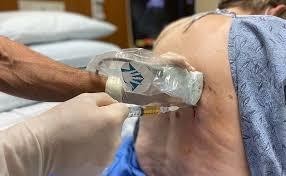A client receives a prescription for itraconazole. Which information provided by the client requires additional instruction by the nurse?
Report any difficulty with breathing.
Monitor for changes in stool color.
Avoid the consumption of grapefruit juice.
Take the medication with antacids.
The Correct Answer is D
Itraconazole is an antifungal medication used to treat a variety of fungal infections. Antacids, which are used to treat heartburn and acid reflux, can decrease the absorption of itraconazole in the body. Therefore, it is important to instruct the client to avoid taking itraconazole with antacids. If the client needs to take an antacid, it should be taken at least 2 hours before or after taking itraconazole.
Reporting any difficulty with breathing is important as it can be a sign of an allergic reaction to the medication. Monitoring for changes in stool color is important as it can be an indication of liver dysfunction, which is a potential side effect of itraconazole.
Avoiding the consumption of grapefruit juice is important as it can increase the level of itraconazole in the body, which can increase the risk of side effects.
In summary, the client should be instructed to avoid taking itraconazole with antacids and to take any antacid at least 2 hours before or after taking itraconazole. The client should also be instructed to report any difficulty with breathing and to monitor for changes in stool color. Additionally, the client should avoid consuming grapefruit juice while taking itraconazole.
Nursing Test Bank
Naxlex Comprehensive Predictor Exams
Related Questions
Correct Answer is D
Explanation
A) Incorrect- Dullness bilaterally on percussion is not a normal finding, but it is not an immediate concern after thoracentesis. It may indicate fluid accumulation or consolidation in both lungs, which could be related to other conditions such as pneumonia or heart failure.
B) Incorrect- Serosanguinous drainage from the chest tube is expected after thoracentesis, as long as it is not excessive or continuous. The nurse should monitor the amount and color of the drainage and document it accordingly.
C) Incorrect- Diminished breath sounds in the left lower lobe are also expected after thoracentesis, as the procedure removes fluid and air from the pleural space and reduces lung expansion. The nurse should auscultate the lungs before and after the procedure and compare the findings. The breath sounds should improve gradually as the lung re-expands.
D) Correct- This is a sign of tension pneumothorax, which is a life-threatening complication of thoracentesis. Tension pneumothorax occurs when air accumulates in the pleural space and creates positive pressure that pushes the mediastinum (the heart, great vessels, and trachea) to the opposite side of the chest. This can impair venous return, cardiac output, and respiratory function. The nurse should report this finding to the healthcare provider immediately and prepare to assist with needle decompression or chest tube insertion.

Correct Answer is ["B","D"]
Explanation
The age-related factors that may factor into this client's wound healing are: Decreased epidermal turnover: As people age, the turnover of skin cells decreases, resulting in slower wound healing. This can prolong the healing process and increase the risk of complications.
T-cell function decrease: The immune system's function, including T-cell function, tends to decline with age. T-cells play a crucial role in the immune response and wound healing. Decreased T-cell function can impair the body's ability to fight infection and promote efficient healing.
Insulin resistance and pigmentation changes are not directly age-related factors that impact wound healing. Insulin resistance is a condition related to impaired glucose metabolism and can affect wound healing in individuals with diabetes or other metabolic disorders, but it is not necessarily an age-related factor. Pigmentation changes are primarily cosmetic and do not directly affect the physiological processes involved in wound healing.

Whether you are a student looking to ace your exams or a practicing nurse seeking to enhance your expertise , our nursing education contents will empower you with the confidence and competence to make a difference in the lives of patients and become a respected leader in the healthcare field.
Visit Naxlex, invest in your future and unlock endless possibilities with our unparalleled nursing education contents today
Report Wrong Answer on the Current Question
Do you disagree with the answer? If yes, what is your expected answer? Explain.
Kindly be descriptive with the issue you are facing.
